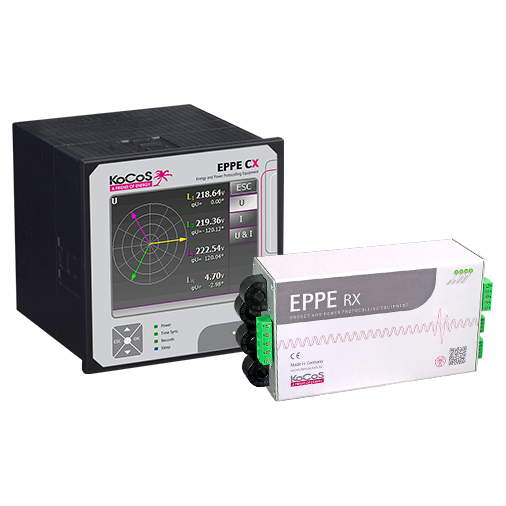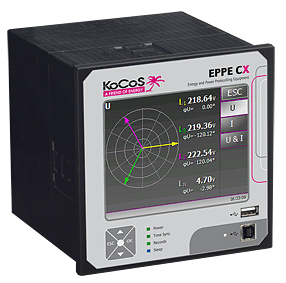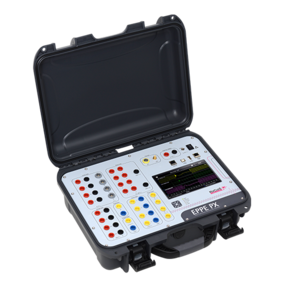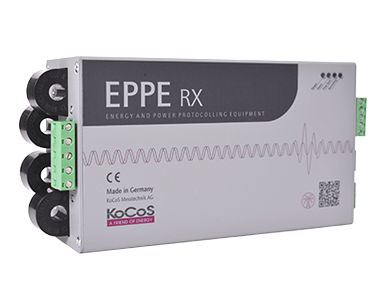
The standard-compliant measurement of power quality ensures an objective and comparable assessment, which is essential for the diagnosis and elimination of power quality problems. Compliance with relevant norms and standards such as IEC 61000-4-30, -15 and -7 ensures that the measurements are accurate, reproducible and reliable.
In Europe, the power quality characteristics are evaluated in accordance with standards such as EN 50160 and IEC 61000-2-2 or -4. Other standards such as NRS048 for South Africa or FoL for Norway are also supported. An editor also enables the creation of evaluation rules for individual grid codes.
The results of the PQ measurement are documented in a standard-compliant report that contains all relevant measurement data, analyses and evaluations. This makes it possible to evaluate the power quality and identify any deviations from the limit values.
In addition to the standard-compliant evaluation of the power quality, the recording of the number and duration of short-term voltage events is a decisive feature for the quality and reliability of the power supply. These events, such as sudden load changes, switching operations, mains faults or lightning strikes, can disrupt or even damage connected devices.
The EPPE not only records the characteristics of voltage dips, voltage peaks (surges) and short and long-term interruptions, but also records their signature as an RMS value curve with a time resolution of one half-wave (T/2).
Thanks to the extremely powerful KoCoS hardware, the 10 recording instruments of the EPPE can be activated simultaneously without influencing each other.

User management using role-based access control makes it possible to restrict users to activities that correspond to their role and to protect the system from unauthorized access.
As an alternative to the system's own user administration, the EPPE system can be connected to external user management systems via the LDAP protocol. Naturally with redundancy and fallback level.
Highly encrypted data transmission makes a significant contribution to secure operation in critical infrastructure systems (KRITIS).
All security-relevant processes are logged. Among other things, user logins, configuration changes or updates are saved in the device. In addition, this data can be transferred to a central network monitoring server using the SYSLOG protocol.
Device firmware and all update files are digitally signed and encrypted to protect against manipulation by faulty updates or updates not approved by the manufacturer.
The EPPE is equipped with two independent fault recorder units that can record transients of a few µs.
The two fault recorders can be individually adjusted in terms of their sampling rate, recording length for pre-fault, fault and post-fault history, the recording criteria (trigger) and the downstream message chain and can therefore be adapted to different measuring tasks.
Up to four independent RMS continuous recordings can be parameterized in the EPPE, which can be executed simultaneously. Any measured values can be assigned to each recording. The interval times for averaging can even be assigned individually to each measured value.
This flexibility makes it possible to adapt the measurements to the specific requirements of different applications.
If EPPE is integrated into a communication network or is accessible via LTE/5G routers, the associated Expert software enables fully automated and database-based metering point operation with automated analysis and reporting.
Fault recordings are transmitted with priority and can be printed out or sent by e-mail as a report together with information on the type of fault, duration, maximum values reached, event log of the protection and switching device messages and details of the fault impedance and fault location.
Power quality reports are generated automatically or manually and can be provided in various data formats, which enables simple, fast and reliable assessment of the power quality.
The device can be accessed in parallel via two independent Ethernet interfaces. This means that EPPE can be accessed via two physically separate networks. These can be, for example, a highly secure internal station network and an external network for remote access.
Live measurement data can be viewed in any web browser via the integrated web server.
Third-party applications can be supplied with data via IEC 61850 and MODBUS TCP as well as via the device's internal (S)FTP server.
The triggered RMS(T2) recorder of the EPPE is specially designed to analyze slow changes such as grid oscillations or balancing processes. These can be caused, for example, by short circuits, load shedding, switching operations, generator failures or lightning strikes. Analyzing these processes is crucial for assessing and improving system stability and helps to detect and rectify potential faults at an early stage to avoid unplanned shutdowns.
The RMS recorder records important signals such as current and voltage amplitudes, frequency, unbalance, power values or impedances with a high temporal resolution of up to twice the grid frequency (T/2) and an event duration of up to 60 minutes.
Another task is to record transient faults that do not directly lead to grid shutdowns but can damage connected consumers in the long term or impair their function. By analyzing this data, sources of interference can be identified and the power quality improved.
A typical measurement task is the recording of actual grid faults, where an automatic fault analysis must be carried out immediately after recording and a fault report including fault characteristics, fault location calculation and event log of the associated protection and switch messages must be created and sent in order to be able to rectify the grid fault quickly and in a targeted manner.
Both application examples can be carried out simultaneously using the two fault recorder units of the EPPE. The recording duration of a disturbance recording can be up to 400,000 sampling points per channel, which corresponds to a recording duration of 40 seconds at 10 kHz or 400 seconds at 1 kHz recording rate, for example.
Optimize your energy quality with precise measurements, reliable software and the highest safety standards. Our solutions help you to identify sources of interference, reduce energy costs and ensure compliance with international standards - flexible, user-friendly and future-proof.

Système stationnaire de surveillance de la qualité de l'énergie pour montage sur panneau
Notre EPPE CX est le choix idéal pour la surveillance permanente et entièrement automatique de la qualité de l'énergie et du réseau. En outre, 16 entrées numériques enregistrent toutes les réactions des dispositifs de protection et de commutation concernés, ce qui permet d'analyser les défauts du réseau et toute leur chaîne d'effets en un seul enregistrement. L'écran tactile de 5 pouces permet d'accéder facilement aux mesures en direct et aux tendances sous forme numérique ou graphique. Grâce à son système d'alarme intégré, il vous informe immédiatement en cas d'irrégularités.

La solution de qualité d'énergie portable dans une mallette de transport
Pour les utilisateurs qui ont besoin de mobilité, notre EPPE PX offre la solution parfaite. La mallette robuste peut résister à des conditions environnementales difficiles. Avec des entrées de capteur supplémentaires, des entrées de courant continu et des entrées analogiques entièrement isolées galvaniquement, il offre une flexibilité maximale pour les mesures mobiles et la surveillance des systèmes.

Analyseur de qualité d'énergie et enregistreur de défauts compact pour montage sur rail DIN
Notre EPPE RX est un analyseur de qualité d'énergie et de mesure de puissance de haute précision pour montage sur rail DIN. Avec 8 canaux, il mesure 4 tensions et 4 courants à une fréquence d'échantillonnage de 200 kHz. Conforme aux normes VDE-AR-N-4110 et VDE-AR-N-4120, il est idéal pour la surveillance des systèmes EEG dans le réseau moyenne et haute tension.